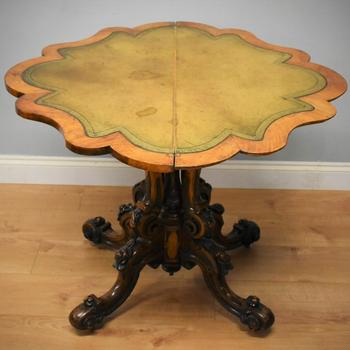Halloween: Victorian Spiritualism & Antiques
Posted by Gillian Jones on 13/10/2023
Winter comes closer and closer, the nights are drawing in - and, by the time you’ve read this, you may have already celebrated Halloween. If you have children then you may have paid even more attention.
Halloween has gained a huge momentum as a time for celebration, fancy dress and plenty of fun. This is a lesson that, perhaps, we’ve learnt from the Americans, who’ve always enjoyed celebrating Halloween.
In this blog post we discover how Halloween became so popular, and recommend some antique pieces to get you in a frightful mood this October.
In this article:
- The rise of the spiritualist
- Industrial Revolution, science, technology and progress
- Ghost Whisperer
- Female spiritualists
- Royal believers
- Progress and communication
- Fancy a séance of your own?
- Halloween antiques
- Our other top pieces this Halloween
The rise of the spiritualist
Perhaps in part we can thank the Victorians for their belief in Spiritualism for our love of a good ghost story.
Spiritualism had its roots in America, but soon caught in Victorian England. During the mid-Victorian period it was popular to gather round a card table of an evening, along with other like-minded individuals and a well-known spiritualist and communicate with the afterlife.
Industrial Revolution, science, technology and progress
The Victorian era has become associated with a time of great advancement in science and technology, so an active interest in spiritualism may seem a little jarring with the progress going on at the time. However, it didn’t stop Victorians from believing in clairvoyance, crystal gazing and the supernatural.
Ghost Whisperer
The core belief during the Victorian period was that with the help of an experienced spiritualist or medium, the living could get in touch with the dead.
A belief that was largely due to the famous Fox sisters of New York in the United States who claimed to have been in touch with the ghost of a man who was murdered in their home years before they lived there.
Female spiritualists
As you can imagine the rise of spiritualism meant there were an awful lot of both men and women claiming to have an exclusive line of communication with the dead. Women especially were considered to be better communicators with the spirits than men due to their sex and were popular throughout the nineteenth century.
In fact, there were as many women believers as there were spiritualists. This feverish interest in the world of spirits continued right until the end of the century.
Royal believers
Queen Victoria was also a firm supporter of the spiritualist movement and attended séances with her husband Prince Albert during the mid-19th century. The spiritualist movement was full of tricks and magic, including table tipping and rapping, automatic writing and levitation.
Ghost stories
There was plenty of literature to help them feed their morbid interest in the dead with ghost stories, myths, fairy tales and even pantomimes. Gothic tales of vampires and bloodlust kept the Victorians spellbound.
Progress and communication
And the progress of technology only helped the dead rather than hinder. Anything could be used for the spirits of loved ones to communicate, from telephones to telegraph wires. The new technology was an instrument to allow the dead to communicate with the living.
Fancy a séance of your own?
If that’s created enough of an atmosphere for you with the winter nights drawing in, you can always tell a good ghost story or two at the bewitching hour. Perhaps you could bring out the Victorian dolls and your card table and gather round and see if the spirits want to communicate.
Halloween antiques
We recommend an authentic Victorian card table for an impromptu gathering in the darkness. Or perhaps you’d like to purchase a rather unsettling Victorian biske doll's head to add a little frisson to your night’s adventures? This early 18th century blood-letting dish may make you feel a little squeamish.
If you're more of a Poirot person, you could explore our range of daggers (it must have been Colonel Mustard in the Library?), an authentic Victorian top hat, or an antique walking cane.
Our other top pieces this Halloween:
- Biske Head German Am Doll, £175
- Good Large Antique Pine Box Chest Table, £145
- Saw Back 1850 British Pioneers Side Arm, £495
- Edison Phonograph With Huge Witches Hat Horn, £2,750
- Japanese Carved Seated Skeleton Figure Wooden Netsuke, £495
- Rare Pair of Skeleton Ladies Earrings Hallowe’en Specials, £75
Whatever you decide, indulge your spiritual side and enjoy the winter, the Victorians certainly did.
Sleep well.






